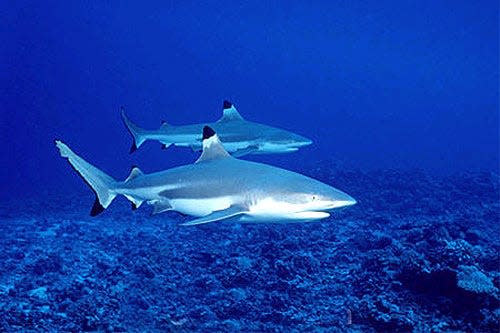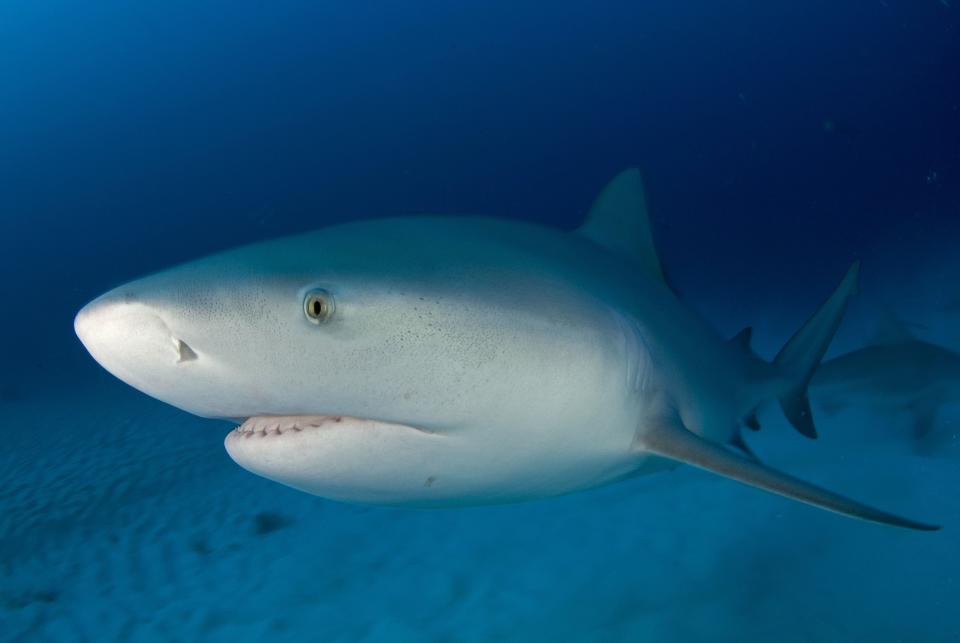Shark bites in Volusia: Why do sharks swim near people? And why are bites rarely fatal?
For most people, shark fins circling shallow ocean waters near the shore is a terrifying sight.
But this scene isn't completely unusual in Volusia County beaches and statewide, and locals have grown used to it. Why? Because sharks swimming in our local waters rarely results in tragedy. Although bites do happen, they often lead to non-life-threatening injuries.
According to trackingsharks.com, a website that specializes in reporting shark attacks and bites across the globe, there have been 16 shark bites in Florida this year, none of which were fatal. Out of 56 bites reported worldwide, eight have been fatal.
The two shark species mostly involved in biting incidents in Volusia County, blacktip and bull sharks, do not pose a significant threat to humans — if you take the necessary precautions.
This year, there have been four shark bites in Volusia County as of Aug. 21 — all four in New Smyrna Beach, which is known as the shark bite capital of the world.
Shark bites decreasing? Florida is the shark bite capital of the world, but attacks are down in 2023
What are blacktip and bull sharks?
Blacktips and bull sharks are just two of nearly 300 shark species in the world. And only about 12 are known to have run-ins with humans.
But these two species have their own unique features.
According to the National Oceanic and Atmospheric Administration’s (NOAA) Fisheries department, blacktip sharks are gray to gray-brown, with white on their bellies and a conspicuous wedge-shaped band or Z-shaped line on the sides.

They grow quickly and can reach up to 6 feet in length. Males mature at 4 to 5 years of age, while females mature later, at 6 to 7 years of age.
Many of the blacktips involved in biting incidents are juveniles. Pups are born in shallow nursery grounds away from the adult population. After giving birth, the females leave the nursery area while juveniles remain.
Bull sharks, on the other hand, are generally larger than blacktips, reaching between 7 and 11 feet in length, according to the National Wildlife Federation.
They have a dark coloration on top and light coloration on the underbelly.

Bull sharks are slightly more dangerous than blacktips, as they have a tendency to migrate from shallow coastal waters up to nearby rivers, bays and estuaries, where they can survive for long periods of time and making it possible for more frequent interaction with humans.
What do these sharks do near the beach?
According to the Dutch Shark Society, these sharks stay close to the shoreline for a number of factors:
Water temperature: Sharks are drawn to warmer water temperature, which explains why biting incidents often happen in the summer.
Abundance of food: They usually eat bony fish, smaller sharks, squids, stingrays, shrimp and crabs. They often follow fishing boats and are sometimes seen consuming discarded fish.
Safety for their young: Shallow water gives female sharks a safe spot to establish nursery areas, where pups are born (also during summertime).
Why do sharks bite people?
According to NOAA, sharks don't attack people because of predation – humans are not part of any shark species’ diet.
“Sharks evolved millions of years before humans existed and therefore humans are not part of their normal diets,” according to NOAA. “Sharks are opportunistic feeders, but most sharks primarily feed on smaller fish and invertebrates.”
Even larger shark species won’t prey on humans if they don’t need to and will instead opt to go after seals or sea lions. When a shark does bite a person, the animal will have likely been “confused or curious.”
“If a shark sees a human splashing in the water, it may try to investigate, leading to an accidental attack” as they act to protect their young, their territory, or simply mistake a swimmer’s foot for potential food, according to NOAA.
Last month: DeLand man bitten by shark while surfing off New Smyrna Beach; 2nd shark bite of year
That's why many of the attacks reported in New Smyrna Beach come from surfers.
How can I avoid being bitten by a shark?
Although they are often not fatal, a shark bite can cause a significant injury.
Here are some tips to follow to avoid being bitten by a shark in the water, according to the Florida Fish and Wildlife Conservation Commission:
Always stay in groups since sharks are more likely to bite a solitary individual.
Avoid being in the water during darkness or twilight hours when sharks are most active.
Don't wear shiny jewelry. When light reflects off shiny jewelry, it resembles the sheen of fish scales.
Avoid waters with known discharges or sewage and waters used for any type of fishing – especially if there are signs of bait fish or feeding activity. Diving seabirds, which frequently feed on bait fishes, are good indicators of such activity.
Use extra caution when waters are murky.
Remember that sharks see contrast particularly well. Uneven tans and brightly colored clothing may draw a shark's attention.
Refrain from excess splashing, as this may draw a shark's attention.
Do not allow pets in the water: their erratic movements may draw a shark’s attention.
Be careful when occupying the area between sandbars or near steep drop-offs – these are favorite hangouts for sharks.
Swim only in areas tended by lifeguards.
Do not enter the water if sharks are known to be present and get out of the water if sharks are sighted.
Never harass a shark!
This article originally appeared on The Daytona Beach News-Journal: Florida shark bites from blacktips, bull sharks are rarely fatal

